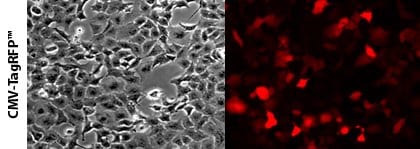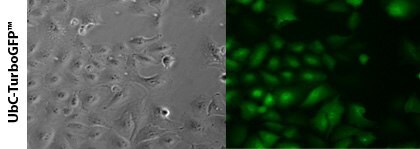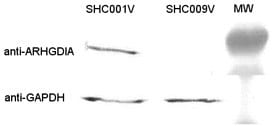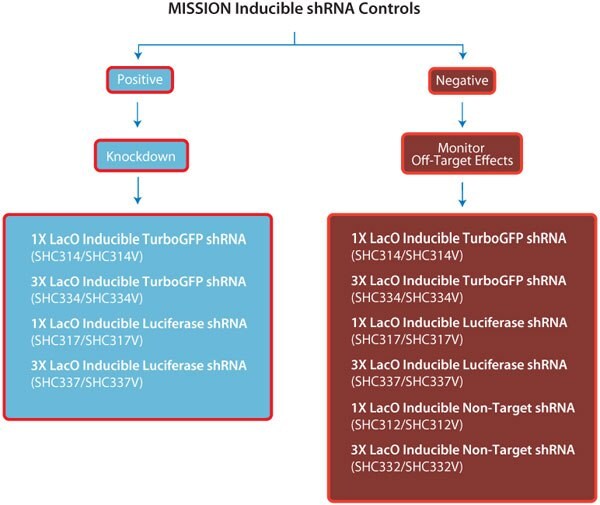MISSION® Lentiviral Controls
When conducting shRNA experiments, proper controls are a key element of experimental design. Proper use of controls permits accurate interpretation of knockdown results and provides assurance of the specificity of the observed phenotype. We offer a variety of positive, negative, and transduction controls to meet these needs. All controls are available in both purified plasmid DNA and lentiviral particle format. Controls in DNA format may be used in direct transfection-based experiments or may be used in conjunction with the MISSION® Lentiviral Packaging Mix (SHP001) to create replication incompetent viral particles for use in transduction-based experiments. In addition, our most popular controls are now offered in high titer format "off the shelf!" These controls are provided in lentiviral format with a minimum titer of 109 TU/ml (p24 assay). All other controls, as well as any MISSION® TRC shRNA, can be prepared in high titer format through our custom lentiviral production process.
The MISSION® research and development team, in collaboration with the RNAi Consortium (TRC) scientists, have generated a series of controls to enable successful implementation of your shRNA experiments. The base vector, TRC1.5-pLKO.1-puro1 was developed at the Broad Institute as part of TRC. Exclusive to our company, TRC1.5 contains almost 200,000 clones including more than 49,000 validated clones. It combines all of the content from TRC1 plus an additional 39,212 clones targeting 2,661 new human genes and 2.395 mouse genes. TRC1.5 clones are in the exact same vector backbone as TRC1 clones.
We are both a collaborative member and supplier of TRC1.5 and TRC2. The TRC2 vector is slightly different. The only change between the TRC1.5 vector and the TRC2 vector is the addition of the WPRE (or the Woodchuck Hepatitis Post-Transcriptional Regulatory Element).2 Because there are two vector backbones, we also provide two sets of controls for the best experimental results.
Constitutively expressed shRNAs are useful for most RNAi needs, but further characterization often requires the ability to tune gene expression. Regulating expression is especially important when studying essential and lethal genes. We are proud to offer IPTG-inducible shRNA vectors as the latest development from our continued partnership in TRC.
Go directly to:
MISSION TRC1.5 shRNA Controls
TRC1.5 Control Descriptions
TRC1.5 Negative Controls
TRC1.5 Positive Controls for Transduction/Transfection
TRC1.5 Positive Controls for Knockdown
MISSION TRC2 shRNA Controls
TRC2 Control Descriptions
TRC2 Negative Controls
TRC2 Positive Controls for Transduction/Transfection
TRC2 Positive Controls for Knockdown
MISSION Inducible shRNA Controls
Inducible Control Descriptions
Inducible Negative Controls
Inducible Positive Controls for Knockdown

TRC1.5 Control Descriptions
Note: Vector maps for all controls can be found on the shRNA Vector Maps page.
TRC1.5 Negative Controls
Untreated Cells
The first recommendation for a negative control for any good experiment is untreated cells. Untreated cells will provide a reference point for comparing all other samples.
Empty Vector Control (SHC001, SHC001V, SHC001H)
The empty vector, TRC1.5-pLKO.1-puro, is a useful negative control that will not activate the RNAi pathway because it does not contain an shRNA insert. It will allow for observation of cellular effects of the transfection process or the delivery of the lentiviral vector. Cells transfected with the empty vector provide a useful reference point for comparing specific knockdown.
Non-Targeting shRNA Controls (SHC002, SHC002V, SHC002H, SHC016, SHC016V, SHC016H)
These non-targeting shRNA vectors are useful negative controls that will activate RISC and the RNAi pathway, but do not target any human or mouse genes. The Non-Mammalian non-target control has been found to target a portion of tGFP. If you are experimenting with tGFP expressing cell lines, you should consider purchasing our newest non-target shRNA control, which has been bioinformatically determined not to target any gene in any species. This allows for examination of the effects of shRNA transduction and RNAi activation on gene expression. Cells transfected with the non-target shRNA vectors will also provide a useful reference for interpretation of knockdown.
TRC1.5 Positive Controls for Transduction/Transfection
We now offer a wide variety of controls with fluorescent reporters for the TRC1.5-pLKO.1-puro backbone. Additionally, we offer two fluorescent reporter controls with an alternate promoter driving the fluorophores, Ubiquitin C (UbC). The table and figure below show the excitation and emission wavelengths for the fluorescent proteins used in our fluorescent protein controls.
Excitation and Emission Wavelengths for Fluorescent Proteins

TurboGFP Control vector (SHC003, SHC003V, SHC003H)
This vector is a useful control for measuring transfection efficiency and optimizing shRNA delivery. The TurboGFP™ Control vector consists of the lentiviral backbone vector, pLKO.1-puro, containing a gene encoding TurboGFP, driven by the CMV promoter. Transfection of this vector provides fast visual confirmation of successful transfection and delivery.

Cells expressing TurboGFP 48 hours post-transduction. Lentiviral titer was estimated to be 1.0 x 106 TU/ml using a p24 based ELISA.
TagRFP Control vector (SHC012, SHC012V)
This is a useful control for measuring transduction efficiency and optimizing shRNA delivery. The TagRFP™ Control vector consists of the lentiviral backbone vector, pLKO.1-puro, containing a gene encoding TagRFP, driven by the CMV promoter. This control provides visual confirmation of successful transduction.

Cells expressing TagRFP 6 days post-transduction at an MOI of 5.
UbC-TurboGFP Control Vector (SHC014, SHC014V)
This is a useful control for measuring transduction efficiency and optimizing shRNA delivery. The TurboGFP™ Control vector consists of the lentiviral backbone vector, pLKO.1-puro, containing a gene encoding TurboGFP, driven by the UbC promoter. This control provides visual confirmation of successful transduction.

Cells expressing UbC-TurboGFP 6 days post-transduction at an MOI of 5.
TRC1.5 Positive Controls for Knockdown
TurboGFP shRNA (SHC004, SHC004V, SHC004H)
The TurboGFP shRNA vector consists of the TRC1.5-pLKO.1–puro vector, containing shRNA that targets TurboGFP, and can be used as a positive control to quickly visualize knockdown. This TurboGFP shRNA control has been experimentally shown to reduce GFP expression by 99.6% in HEK293T cells after 24 hours.



Knockdown efficiency of eGFP shRNA in HEK293T cells. Images shown 48 hours post-transfection. A) 100 ng of eGFP expression plasmid alone. B) 100 ng eGFP plasmid + 200 ng MISSION eGFP shRNA Control Vector. C) Bright field illumination.
Luciferase shRNA (SHC007, SHC007V)
The MISSION Luciferase shRNA vector consists of the TRC1.5-pLKO.1-puro vector, containing an shRNA insert that targets luciferase from North American Firefly, Photinus pyralis (GenBank Accession No. M15077). This control can be used as a positive control to quickly confirm knockdown.
Human Positive Control #1, B2M shRNA
B2M is a widely expressed gene, and the protein is found on the surface of most cells. This control will provide clear and measurable knockdown of the human gene target, typically 80-90% in A549 cells, a human epithelial lung carcinoma cell line. In our experiments, we used an MOI of 3, and cells were placed under puromycin selection 1 day post-transduction and grown for 1-2 weeks. The RNA analysis was done using B2M-specific primer probe sets. Western blot data also showed knockdown with this control.
Human Positive Control #2, ARHGDIA shRNA
This control will provide clear and measurable knockdown of the human gene target, typically 80-90% in A549 cells, a human epithelial lung carcinoma cell line. Rho GDP Dissociation Inhibitor (GDI) alpha (ARHGDIA) is a widely expressed gene, and the protein is found intracellularly in most cells.

A549 cells were transduced with either the empty vector control, SHC001V. Cell lysates were then prepared. After determining that mRNA levels had been depleted via hyperbranched PCR, protein levels were probed via Western Blot using anti-ARGHDIA antibody, R3025. Nearly total elimination of protein was observed.

TRC2 Control Descriptions
Note: Vector maps for all controls can be found on the shRNA Vector Maps page.
TRC2 Negative Controls
Untreated Cells
The first recommendation for a negative control for any good experiment is untreated cells. Untreated cells will provide a reference point for comparing all other samples.
Empty Vector Control (SHC201, SHC201V)
The empty vector, TRC2-pLKO-puro, is a useful negative control that will not activate the RNAi pathway because it does not contain an shRNA insert. It will allow for observation of cellular effects of the transfection process or the delivery of the lentiviral vector. Cells transfected with the empty vector provide a useful reference point for comparing specific knockdown.
Non-Targeting shRNA Controls (SHC202, SHC202V, SHC216, SHC216V)
These non-targeting shRNA vectors are useful negative controls that will activate RISC and the RNAi pathway, but do not target any human or mouse genes. The Non-Mammalian non-target control has been found to target a portion of tGFP. If you are experimenting with tGFP expressing cell lines, you should consider purchasing our newest non-target shRNA control, which has been bioinformatically determined not to target any gene in any species. This allows for examination of the effects of shRNA transduction and RNAi activation on gene expression. Cells transfected with the non-target shRNA vectors will also provide a useful reference for interpretation of knockdown.
TRC2 Positive Control for Transduction/Transfection
TurboGFP Control vector (SHC203, SHC203V)
This vector is a useful control for measuring transfection efficiency and optimizing shRNA delivery. The TurboGFP™ Control vector consists of the lentiviral backbone vector, TRC2-pLKO-puro, containing a gene encoding TurboGFP, driven by the CMV promoter. Transfection of this vector provides fast visual confirmation of successful transfection and delivery.
TRC2 Positive Control for Knockdown
TurboGFP shRNA (SHC204, SHC204V)
The TurboGFP shRNA vector consists of the TRC2-pLKO–puro vector, containing shRNA that targets TurboGFP, and can be used as a positive control to quickly visualize knockdown. This TurboGFP shRNA control has been experimentally shown to reduce GFP expression by 99.6% in HEK293T cells after 24 hours.

Inducible shRNA Control Descriptions
Note: Vector maps for all controls can be found on the shRNA Vector Maps page.
Inducible shRNA Negative Controls
Untreated Cells
The first recommendation for a negative control for any good experiment is untreated cells. Untreated cells will provide a reference point for comparing all other samples.
Inducible Non-Targeting shRNA Controls (SHC312, SHC312V, SHC332, SHC332V)
These MISSION non-targeting inducible shRNA vectors are useful negative controls that will activate RISC and the RNAi pathway, but do not target any known genes in any species. This allows for examination of the effects of shRNA transduction and RNAi activation on gene expression. Cells transfected with the non-target inducible shRNA vectors will also provide a useful reference for interpretation of knockdown.
Inducible TurboGFP shRNA and Inducible Luciferase shRNA
Because these inducible shRNAs do not target any known human or mouse genes, they can be used as non-targeting controls in many inducible shRNA experiments.
Inducible Positive shRNA Control for Knockdown
Inducible TurboGFP shRNA
The MISSION inducible TurboGFP shRNA vectors consist of the pLKO.5-puro vector, containing shRNA that targets TurboGFP, and can be used as a positive control to quickly visualize knockdown. These TurboGFP shRNA controls have been experimentally shown to reduce GFP expression by 99.6% in HEK293T cells after 24 hours.
Inducible Luciferase shRNA
The MISSION inducible Luciferase shRNA vectors consist of the pLKO.5-puro vector, containing an shRNA insert that targets luciferase from North American Firefly, Photinus pyralis (GenBank Accession No. M15077). These controls can be used as positive controls to quickly confirm knockdown.
References
MISSION is a registered trademark of Sigma-Aldrich Co. LLC
TurboGFP, TagCFP, TagYFP, TagRFP, TagFP635 are trademarks of Evrogen.
To continue reading please sign in or create an account.
Don't Have An Account?